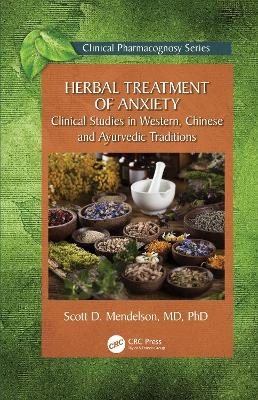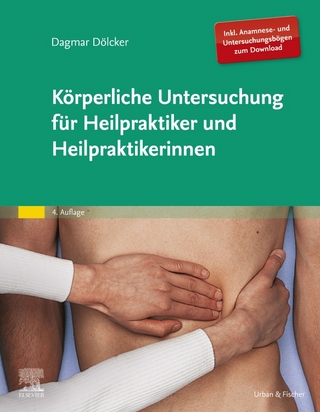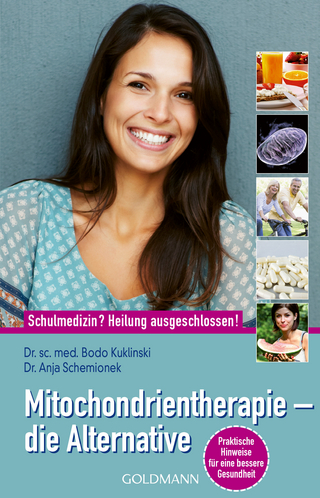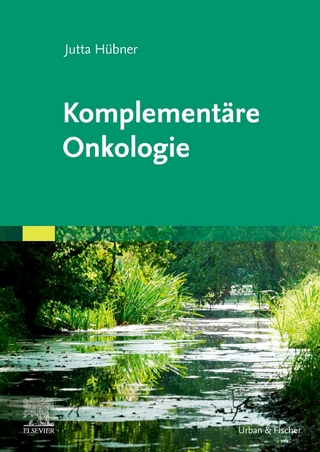
Herbal Treatment of Anxiety
CRC Press (Verlag)
978-1-032-29159-8 (ISBN)
Herbal Treatment of Anxiety: Clinical Studies in Western, Chinese and Ayurvedic Traditions explains the nature and types of anxiety, its neurobiology, the pathophysiology that exacerbates and perpetuates it, and the psychopharmacology of the chemical agents that relieve its manifestations. Throughout the text are discussions of Western, Chinese and Ayurvedic herbal treatments that have been clinically shown to be effective in relieving anxiety. The book also features a scientific discussion of the use of herbs and essential oils in aromatherapy and the mechanisms by which they may work. The book concludes by providing bases upon which herbs can be chosen to treat the anxiety of patients according to their individual needs.
Additional features include:
Examines the increasingly popular subject of the use of herbs as a natural alternative treatment and provides a much-needed scientific basis for treatments often considered as merely "folk medicine."
Discusses the psychoactive phytochemicals contained in herbs.
Includes a chapter discussing the nature and mechanisms of action of adaptogens.
Adds to the armamentarium of anxiolytics for providers who have become reluctant to prescribe benzodiazepines as treatment of anxiety, particularly in the context of the opiate crisis.
Gives an introduction to herbal treatments of traditional Chinese and Ayurvedic medicine.
Offers practical advice on initiating and managing herbal treatments.
Herbal Treatment of Anxiety is a valuable reference for psychiatrists, psychiatric nurse practitioners, primary care providers, naturopathic doctors and therapists interested in the most current scientific information on the effects of herbal treatments of anxiety disorders.
Scott D. Mendelson is a practicing psychiatrist in Roseburg, Oregon. He earned a Ph.D. in biopsychology at the University of British Columbia in Vancouver, Canada. He then worked for three years as a postdoctoral fellow at The Rockefeller University in the Laboratory of Neuroendocrinology under Bruce McEwen, Ph.D. During his doctoral work and as a postdoctoral fellow, he published 24 papers on the subjects of serotonergic and hormonal regulation of sexual behavior and the effects of stress on serotonin receptor subtypes in the brain. He then attended medical school at the University of Illinois, and after graduating in 1996, he did his residency in psychiatry at the University of Virginia. In 2007, Elsevier published his first book, Metabolic Syndrome and Psychiatric Illness: Interactions, Pathophysiology, Assessment and Treatment. In 2009, M. Evans published his second book, Beyond Alzheimer’s: How to Avoid the Modern Epidemic of Dementia.
Contents
Chapter 1. What is anxiety?
References
Chapter 2. Non-pharmacological treatments of Anxiety
References
Chapter 3. The Neurobiology of Anxiety
3.1 Brain Circuitry of anxiety
3.2 Neurochemistry
3.2.1 Gamma amino butyric acid
3.2.2 Glutamate
3.2.3 Monoamines
3.2.4 Acetylcholine
3.2.5 Endocannabinoids
3.2.6 Endorphins
3.2.7 Histamine
3.2.8 Glycine
3.3 Stress
3.4 Inflammation
3.5 Metabolic Syndrome
3.6 Summary
References
Chapter 4. Medications commonly used to treat anxiety
4.1 Benzodiazepines
4.2 Buspirone
4.3 Antidepressants
4.4 Gabapentin
4.5 Pregabalin
4.6 Hydroxyzine
4.7 propranolol
4.8 clonidine
4.9 neurosteroids
4.10 Mechanisms of anxiolytic drug action
Chapter 5. Anxiolytic Phytochemicals
5.1 Flavonoids
5.2 Terpenes
5.3 alkaloids
5.4 Phytochemicals that relieve anxiety
5.4.1 Amentoflavone
5.4.2 Apigenin
5.4.3 Baicalein
5.4.4 β-caryophyllene
5.4.5 Bisabolol
5.4.6 Caffeic acid
5.4.7 3-Carene
5.4.8 Carvacrol
5.4.9 Chrysin
5.4.10 7,8,Dihydroxyflavone
5.4.11 Ellagic acid
5.4.12 Epigallocatechin gallate
5.4.13 Eugenol
5.4.14 Ferulic acid
5.4.15 Hispidulin
5.4.16 Hyperoside
5.4.17 Icariin
5.4.18 Isopulegol
5.4.19 Kaempferol
5.4.20 Limonene
5.4.21 Linalool
5.4.22 Luteolin
5.4.23 Menthol
5.4.24 Mangiferin
5.4.25 Myricetin
5.4.26 Naringin
5.4.27 Nerolidol
5.4.28 Nobiletin
5.4.29 Pinene
5.4.30 Resveratrol
5.4.31 Quercetin
5.4.32 Rosmarinic acid
5.4.33 Ursolic acid
5.4.34 Wogonin
Chapter 6. Herbal treatment of anxiety
6.1.1 Acorus calamus
6.1.1 Anxiolytic effects
6.1.1.2 Mechanism of action
6.1.1.3 Dosage
6.1.1.4 Toxicity
6.1.1.5 Safety in pregnancy
6.1.1.6 Drug interaction
6.1.2 Avena sativa
6.1.2.1 Anxiolytic effects
6.1.2.2 Mechanism of action
6.1.2.3 Dosage
6.1.2.4 Toxicity
6.1.2.5 Safety in pregnancy
6.1.2.6 Drug interaction
6.1.3 Bacopa monnieri
6.1.3.1 Anxiolytic effects
6.1.3.2 Mechanism of action
6.1.3.3 Dosage
6.1.3.4 Toxicity
6.1.3.5 Safety in pregnancy
6.1.3.6 Drug interaction
6.1.4 Camellia sinensis
6.1.4.1 Anxiolytic effects
6.1.4.2 Mechanism of action
6.1.4.3 Dosage
6.1.4.4 Toxicity
6.1.4.5 Safety in pregnancy
6.1.4.6 Drug interaction
6.1.5 Cannabis sativa
6.1.5.1 Anxiolytic effects
6.1.5.2 Mechanism of action
6.1.5.3 Dosage
6.1.5.4 Toxicity
6.1.5.5 Safety in pregnancy
6.1.5.6 Drug interaction
6.1.6 Centella asiatica
6.1.6.1 Anxiolytic effects
6.1.6.2 Mechanism of action
6.1.6.3 Dosage
6.1.6.4 Toxicity
6.1.6.5 Safety in pregnancy
6.1.6.6 Drug interaction
6.1.7 Cinnamomum spp
6.1.7.1 Anxiolytic effects
6.1.7.2 Mechanism of action
6.1.7.3 Dosage
6.1.7.4 Toxicity
6.1.7.5 Safety in pregnancy
6.1.7.6 Drug interaction
6.1.8 Citrus aurantium
6.1.8.1 Anxiolytic effects
6.1.8.2 Mechanism of action
6.1.8.3 Dosage
6.1.8.4 Toxicity
6.1.8.5 Safety in pregnancy
6.1.8.6 Drug interaction
6.1.9 Convolvulus pluricaulis
6.1.9.1 Anxiolytic effects
6.1.9.2 Mechanism of action
6.1.9.3 Dosage
6.1.9.4 Toxicity
6.1.9.5 Safety in pregnancy
6.1.9.6 Drug interaction
6.1.10 Crocus sativa
6.1.10.1 Anxiolytic effects
6.1.10.2 Mechanism of action
6.1.10.3 Dosage
6.1.10.4 Toxicity
6.1.10.5 Safety in pregnancy
6.1.10.6 Drug interaction
6.1.11 Curcuma longa
6.1.11.1 Anxiolytic effects
6.1.11.2 Mechanism of action
6.1.11.3 Dosage
6.1.11.4 Toxicity
6.1.11.5 Safety in pregnancy
6.1.11.6 Drug interaction
6.1.12 Echinacea angustifolia
6.1.12.1 Anxiolytic effects
6.1.12.2 Mechanism of action
6.1.12.3 Dosage
6.1.12.4 Toxicity
6.1.12.5 Safety in pregnancy
6.1.12.6 Drug interaction
6.1.13 Echium amoenum
6.1.13.1 Anxiolytic effects
6.1.13.2 Mechanism of action
6.1.13.3 Dosage
6.1.13.4 Toxicity
6.1.13.5 Safety in pregnancy
6.1.13.6 Drug interaction
6.1.14 Eleutherococcus senticosus
6.1.14.1 Anxiolytic effects
6.1.14.2 Mechanism of action
6.1.14.3 Dosage
6.1.14.4 Toxicity
6.1.14.5 Safety in pregnancy
6.1.14.6 Drug interaction
6.1.15 Eschscholzia californica
6.1.15.1 Anxiolytic effects
6.1.15.2 Mechanism of action
6.1.15.3 Dosage
6.1.15.4 Toxicity
6.1.15.5 Safety in pregnancy
6.1.15.6 Drug interaction
6.1.16 Euphytose
6.1.16.1 Anxiolytic effects
6.1.16.2 Mechanism of action
6.1.16.3 Dosage
6.1.16.4 Toxicity
6.1.16.5 Safety in pregnancy
6.1.16.6 Drug interaction
6.1.17 Evolvulus alsinoides
6.1.17.1 Anxiolytic effects
6.1.17.2 Mechanism of action
6.1.17.3 Dosage
6.1.17.4 Toxicity
6.1.17.5 Safety in pregnancy
6.1.17.6 Drug interaction
6.1.18 Foeniculum vulgare
6.1.18.1 Anxiolytic effects
6.1.18.2 Mechanism of action
6.1.18.3 Dosage
6.1.18.4 Toxicity
6.1.18.5 Safety in pregnancy
6.1.18.6 Drug interaction
6.1.19 Galphimia glauca
6.1.19.1 Anxiolytic effects
6.1.19.2 Mechanism of action
6.1.19.3 Dosage
6.1.19.4 Toxicity
6.1.19.5 Safety in pregnancy
6.1.19.6 Drug interaction
6.1.20 Ganoderma lucidum
6.1.20.1 Anxiolytic effects
6.1.20.2 Mechanism of action
6.1.20.3 Dosage
6.1.20.4 Toxicity
6.1.20.5 Safety in pregnancy
6.1.20.6 Drug interaction
6.1.21 Ginkgo biloba
6.1.21.1 Anxiolytic effects
6.1.21.2 Mechanism of action
6.1.21.3 Dosage
6.1.21.4 Toxicity
6.1.21.5 Safety in pregnancy
6.1.21.6 Drug interaction
6.1.22 Humulus lupulus
6.1.22.1 Anxiolytic effects
6.1.22.2 Mechanism of action
6.1.22.3 Dosage
6.1.22.4 Toxicity
6.1.22.5 Safety in pregnancy
6.1.22.6 Drug interaction
6.1.23 Hypericum perforatum
6.1.23.1 Anxiolytic effects
6.1.23.2 Mechanism of action
6.1.23.3 Dosage
6.1.23.4 Toxicity
6.1.23.5v Safety in pregnancy
6.1.23.6 Drug interaction
6.1.24 Lavandula angustifolia
6.1.24.1 Anxiolytic effects
6.1.24.2 Mechanism of action
6.1.24.3 Dosage
6.1.24.4 Toxicity
6.1.24.5 Safety in pregnancy
6.1.24.6 Drug interaction
6.1.25 Leonurus cardiaca
6.1.25.1 Anxiolytic effects
6.1.25.2 Mechanism of action
6.1.25.3 Dosage
6.1.25.4 Toxicity
6.1.25.5 Safety in pregnancy
6.1.25.6 Drug interaction
6.1.26 Lepidium meyenii
6.1.26.1 Anxiolytic effects
6.1.26.2 Mechanism of action
6.1.26.3 Dosage
6.1.26.4 Toxicity
6.1.26.5 Safety in pregnancy
6.1.26.6 Drug interaction
6.1.27 Lilium brownii
6.1.27.1 Anxiolytic effects
6.1.27.2 Mechanism of action
6.1.27.3 Dosage
6.1.27.4 Toxicity
6.1.27.5 Safety in pregnancy
6.1.27.6 Drug interaction
6.1.28 Lippia citriodora
6.1.28.1 Anxiolytic effects
6.1.28.2 Mechanism of action
6.1.28.3 Dosage
6.1.28.4 Toxicity
6.1.28.5 Safety in pregnancy
6.1.28.6 Drug interaction
6.1.29 Magnolia officinalis
6.1.29.1 Anxiolytic effects
6.1.29.2 Mechanism of action
6.1.29.3 Dosage
6.1.29.4 Toxicity
6.1.29.5 Safety in pregnancy
6.1.29.6 Drug interaction
6.1.30 Matricaria recutita
6.1.30.1 Anxiolytic effects
6.1.30.2 Mechanism of action
6.1.30.3 Dosage
6.1.30.4 Toxicity
6.1.30.5 Safety in pregnancy
6.1.30.6 Drug interaction
6.1.31 Melissa officinalis
6.1.31.1 Anxiolytic effects
6.1.31.2 Mechanism of action
6.1.31.3 Dosage
6.1.31.4 Toxicity
6.1.31.5 Safety in pregnancy
6.1.31.6 Drug interaction
6.1.32 Mentha piperita
6.1.32.1 Anxiolytic effects
6.1.32.2 Mechanism of action
6.1.32.3 Dosage
6.1.32.4 Toxicity
6.1.32.5 Safety in pregnancy
6.1.32.6 Drug interaction
6.1.33 Nardostachys jatamansi
6.1.33.1 Anxiolytic effects
6.1.33.2 Mechanism of action
6.1.33.3 Dosage
6.1.33.4 Toxicity
6.1.33.5 Safety in pregnancy
6.1.33.6 Drug interaction
6.1.34 Ocimum sanctum
6.1.34.1 Anxiolytic effects
6.1.34.2 Mechanism of action
6.1.34.3 Dosage
6.1.34.4 Toxicity
6.1.34.5 Safety in pregnancy
6.1.34.6 Drug interaction
6.1.35 Panax ginseng
6.1.35.1 Anxiolytic effects
6.1.35.2 Mechanism of action
6.1.35.3 Dosage
6.1.35.4 Toxicity
6.1.35.5 Safety in pregnancy
6.1.35.6 Drug interaction
6.1.36 Passifloraceae incarnata
6.1.36.1 Anxiolytic effects
6.1.36.2 Mechanism of action
6.1.36.3 Dosage
6.1.36.4 Toxicity
6.1.36.5 Safety in pregnancy
6.1.36.6 Drug interaction
6.1.37 Piper methysticum
6.1.37.1 Anxiolytic effects
6.1.37.2 Mechanism of action
6.1.37.3 Dosage
6.1.37.4 Toxicity
6.1.37.5 Safety in pregnancy
6.1.37.6 Drug interaction
6.1.38 Poria cocos
6.1.38.1 Anxiolytic effects
6.1.38.2 Mechanism of action
6.1.38.3 Dosage
6.1.38.4 Toxicity
6.1.38.5 Safety in pregnancy
6.1.38.6 Drug interaction
6.1.39 Psilocybe spp
6.1.39.1 Anxiolytic effects
6.1.39.2 Mechanism of action
6.1.39.3 Dosage
6.1.39.4 Toxicity
6.1.39.5 Safety in pregnancy
6.1.39.6 Drug interaction
6.1.40 Rhodiola rosea
6.1.40.1 Anxiolytic effects
6.1.40.2 Mechanism of action
6.1.40.3 Dosage
6.1.40.4 Toxicity
6.1.40.5 Safety in pregnancy
6.1.40.6 Drug interaction
6.1.41 Rosmarinus officinalis
6.1.41.1 Anxiolytic effects
6.1.41.2 Mechanism of action
6.1.41.3 Dosage
6.1.41.4 Toxicity
6.1.41.5 Safety in pregnancy
6.1.41.6 Drug interaction
6.1.42 Salvia officinalis
6.1.42.1 Anxiolytic effects
6.1.42.2 Mechanism of action
6.1.42.3 Dosage
6.1.42.4 Toxicity
6.1.42.5 Safety in pregnancy
6.1.42.6 Drug interaction
6.1.43 Schisandra chinensis
6.1.43.1 Anxiolytic effects
6.1.43.2 Mechanism of action
6.1.43.3 Dosage
6.1.43.4 Toxicity
6.1.43.5 Safety in pregnancy
6.1.43.6 Drug interaction
6.1.44 Scutellaria baicalensis
6.1.44.1 Anxiolytic effects
6.1.44.2 Mechanism of action
6.1.44.3 Dosage
6.1.44.4 Toxicity
6.1.44.5 Safety in pregnancy
6.1.44.6 Drug interaction
6.1.45 Silybum marianum
6.1.45.1 Anxiolytic effects
6.1.45.2 Mechanism of action
6.1.45.3 Dosage
6.1.45.4 Toxicity
6.1.45.5 Safety in pregnancy
6.1.45.6 Drug interaction
6.1.46 Tinospora cordifolia
6.1.46.1 Anxiolytic effects
6.1.46.2 Mechanism of action
6.1.46.3 Dosage
6.1.46.4 Toxicity
6.1.46.5 Safety in pregnancy
6.1.46.6 Drug interaction
6.1.47 Trifolium pratense
6.1.47.1 Anxiolytic effects
6.1.47.2 Mechanism of action
6.1.47.3 Dosage
6.1.47.4 Toxicity
6.1.47.5 Safety in pregnancy
6.1.47.6 Drug interaction
6.1.48 Valeriana jatamansi
6.1.48.1 Anxiolytic effects
6.1.48.2 Mechanism of action
6.1.48.3 Dosage
6.1.48.4 Toxicity
6.1.48.5 Safety in pregnancy
6.1.48.6 Drug interaction
6.1.49 Valeriana officinalis
6.1.49.1 Anxiolytic effects
6.1.49.2 Mechanism of action
6.1.49.3 Dosage
6.1.49.4 Toxicity
6.1.49.5 Safety in pregnancy
6.1.49.6 Drug interaction
6.1.50 Vitex agnus-castus
6.1.50.1 Anxiolytic effects
6.1.50.2 Mechanism of action
6.1.50.3 Dosage
6.1.50.4 Toxicity
6.1.50.5 Safety in pregnancy
6.1.50.6 Drug interaction
6.1.51 Withania somnifera
6.1.51.1 Anxiolytic effects
6.1.51.2 Mechanism of action
6.1.51.3 Dosage
6.1.51.4 Toxicity
6.1.51.5 Safety in pregnancy
6.1.51.6 Drug interaction
6.1.52 Ziziphus jujuba
6.1.52.1 Anxiolytic effects
6.1.52.2 Mechanism of action
6.1.52.3 Dosage
6.1.52.4 Toxicity
6.1.52.5 Safety in pregnancy
6.1.52.6 Drug interaction
6.2 Anxiolytic herbs recommended by experts that remain untested
6.2.1 Borago officinalis
6.2.2 Lactuca virosa
6.2.3 Mimosa pudica
6.2.4 Nepeta cataria
6.2.5 Piscidia erythrina
6.2.6 Taraxacum officinale
6.2.7 Tilia spp.
References
Chapter 7. Chinese herbal treatment of anxiety
7.1 Traditional Chinese treatments of anxiety
7.2 Herbal treatment in Traditional Chinese Medicine
7.2.1 Bai zi yang xin tang with Shu gan ning shen san
7.2.2 Ban xia hou pu
7.2.3 Bao shen
7.2.4 Geng ni an chun
7.2.5 Gui pi tang
7.2.6 Jiu wei zhen xin
7.2.7 Kami-shoyo-san and Hange-koboku-to
7.2.8 Rikkunshinto
7.2.9 Shen qi wu wei zi
7.2.10 Shen song yang xin
7.2.11 Suan Zao Ren Tang in Combination with Zhi Zi Chi Tang
7.2.12 Wen dan tang
7.2.13 Xiao Yao San
7.2.14 Xin wei tang
7.2.15 Yang xin tang
7.2.16 Yi gan san
7.2.17 Yi qi yang xin
7.2.18 Yukgunja and Banhabakchulchunma decoctions
7.3 Traditional but untested anxiolytic Chinese herbal formulas
7.4 The mainstays of Chinese herbal treatments
7.4.1 Acorus gramineus
7.4.2 Albizzia julibrissin
7.4.3 Angelicae gigantis
7.4.4 Bupleurum chinense
7.4.5 Cnidium officinale
7.4.6 Coptis chinensis
7.4.7 Curcumae wenyujin
7.4.8 Cynomorium songaricum
7.4.9 Ganoderma lucidum
7.4.10 Glycyrrhiza uralensis
7.4.11 Paeonia lactiflora
7.4.12 Panax ginseng
7.4.13 Pinellia ternate
7.4.14 Polygala Tenuifolia
7.4.15 Polygonum multiflorum
7.4.16 Poria cocus
7.4.17 Rehmannia glutinosa
7.4.18 Schisandra chinensis
7.4.19 Ziziphus jujuba
Chapter 8. Ayurvedic Herbal Treatment of Anxiety
8.1 Herbal treatment of Anxiety in Ayurvedic Medicine
8.1.1 Ashwagandha Churna
8.1.2 Ashwagandha and mandookaparni
8.1.3 Asparagus racemosus and Glycyrrhiza glabra
8.1.4 Brahmi gritha
8.1.5 Geriforte
8.1.6 Guduchyadi Medhya Rasayana
8.1.7 Kushmandadi Ghrita
8.1.8 Medhyarasayana Ghrita and Vachadi Ghrita Nasya
8.1.9 Mentat
8.1.10 OCTA
8.1.11 Sarasvata choorna
8.1.12 Sarpagandha Ghana Vati
8.1.13 Shankhapushpi Panak and shirodhara with Mamsyadi Kwatha
8.1.14 Shankhapushpyadi Ghana Vati
8.1.15 Vacha Brahmi Ghan
8.1.16 Worry Free
8.2 Mainstays of Ayurvedic Herbal Treatment of Anxiety
8.2.1 Acorus calamus
8.2.2 Albizzia lebbek
8.2.3 Allium cepa
8.2.4 Anacyclus pyrethrum
8.2.5 Asparagus racemosus
8.26. Bacopa monnieri
8.2.7 Benincasa hispida
8.2.8 Cannabis sativa
8.2.9 Centella asiatica
8.2.10 Convolvulus pluricaulis
8.2.11 Cuscuta reflexa
8.2.12 Cynodon dactylon
8.2.13 Evolvulus alsinoides
8.2.14 Ficus religiosa
8.2.15 Glycyrrhiza glabra
8.2.16 Hyoscyamus niger
8.2.17 Juglans regia
8.2.18 Lawsonia inermis
8.2.19 Moringa oleifera
8.2.20 Nardostachys jatamansi
8.2.21 Piper nigrum
8.2.22 Punica granatum
8.2.23 Saussurea lappa
8.2.24 Tinospora cordifolia
8.2.25 Valeriana jatamansi
8.2.26 Vitex negundo
8.2.27 Withania somnifera
Chapter 9. Adaptogens
References
Chapter 10. Aromatherapy
10.1 Herbs utilized in Aromatherapy.
10.1.1 Boswellia carteri
10.1.2 Citrus aurantium
10.1.3 Citrus sinensis
10.1.4 Cymbopogon citratus
10.1.5 Eugenia aromaticum
10.1.6 Jasminum officinale
10.1.7 Lavandula spp
10.1.8 Matricaria recutita
10.1.9 Melissa officinalis
10.1.10 Mentha piperita
10.1.11 Nardostachys jatamansi
10.1.12 Neroli oil
10.1.13 Pelargonium graveolens
10.1.14 Rosa damascene
10.1.15 Rosmarinus officinalis
10.1.16 Salvia officinalis
10.1.17 Santallum spp
10.2 Herbal combinations in aromatherapy
10.2.1 Cymbopogon citratus and Eucalyptus massage with Lavandula officinalis inhalation
10.2.2 Lavandula officinalis, Cananga odorata, and Citrus bergamia
10.2.3 Lavandula officinalis, Chamaemelum nobile, and Citrus aurantium
10.2.4 Lavandula officinalis, Pelargonium graveolens and Citrus reticulata
10.2.5 Lavandula officinalis and Rosa damascene
10.2.6 Lavandula officinalis and Santalum album
10.3 Aromatherapy and sleep
10.4 Some final thoughts about aromatherapy
Chapter 11. Choosing an herbal treatment for anxiety
11.1 Efficacy
11.2 What type of anxiety is being treated?
11.3 Single herbs or combinations?
11.4 Treatment of chronic anxiety disorders
11.5 Comorbidities
11.5.1 Major Depression
11.5.2 Insomnia
11.5.3 Menopause and Dysmenorrhea
11.5.4 Pain
11.5.5 Inflammation
11.5.6 Irritable bowel syndrome
11.5.7 Diabetes
11.5.8 Dementia
11.6 Safety
11.7 Final considerations about the practical use of herbs.
References
| Erscheinungsdatum | 06.07.2022 |
|---|---|
| Reihe/Serie | Clinical Pharmacognosy Series |
| Verlagsort | London |
| Sprache | englisch |
| Maße | 156 x 234 mm |
| Gewicht | 620 g |
| Themenwelt | Sachbuch/Ratgeber ► Gesundheit / Leben / Psychologie ► Alternative Heilverfahren |
| Medizin / Pharmazie ► Medizinische Fachgebiete ► Pharmakologie / Pharmakotherapie | |
| Medizin / Pharmazie ► Naturheilkunde ► Phytotherapie | |
| Medizin / Pharmazie ► Pflege | |
| Medizin / Pharmazie ► Pharmazie ► PTA / PKA | |
| Naturwissenschaften ► Biologie ► Humanbiologie | |
| Naturwissenschaften ► Biologie ► Zoologie | |
| ISBN-10 | 1-032-29159-1 / 1032291591 |
| ISBN-13 | 978-1-032-29159-8 / 9781032291598 |
| Zustand | Neuware |
| Informationen gemäß Produktsicherheitsverordnung (GPSR) | |
| Haben Sie eine Frage zum Produkt? |
aus dem Bereich


